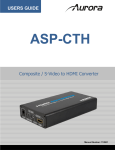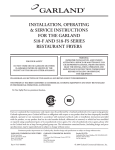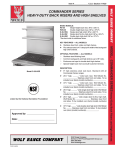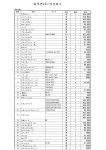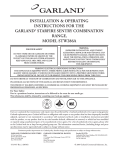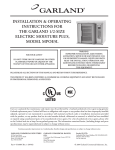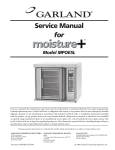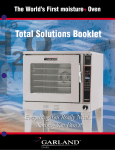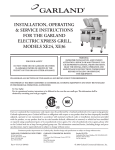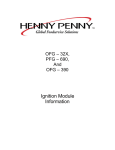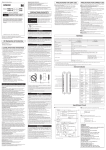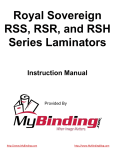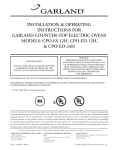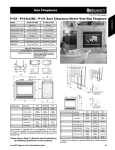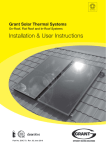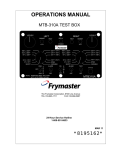Download installation & servicing instructions for the garland® starfire sentry
Transcript
INSTALLATION & SERVICING INSTRUCTIONS FOR THE GARLAND® STARFIRE SENTRY COMBINATION RANGE, MODEL STW286 FOR YOUR SAFETY DO NOT STORE OR USE GASOLINE OR OTHER FLAMMABLE VAPORS OR LIQUIDS IN THE VICINITY OF THIS OR ANY OTHER APPLIANCE. KEEP APPLIANCE AREA FREE AND CLEAR FROM COMBUSTIBLES. WARNING: IMPROPER INSTALLATION, ADJUSTMENT, ALTERATION, SERVICE OR MAINTENANCE CAN CAUSE PROPERTY DAMAGE, INJURY OR DEATH. READ THE INSTALLATION, OPERATION AND MAINTENANCE INSTRUCTIONS THOROUGHLY BEFORE INSTALLING OR SERVICING THIS EQUIPMENT. WARNING: ELECTRICAL GROUNDING INSTRUCTIONS THIS APPLIANCE IS EQUIPPED WITH A THREE-PRONG (GROUNDING) PLUG FOR YOUR PROTECTION AGAINST SHOCK HAZARD. IT SHOULD BE PLUGGED DIRECTLY INTO A PROPERLY GROUNDED THREEPRONG RECEPTACLE. DO NOT CUT OR REMOVE THE GROUNDING PRONG FROM THIS PLUG DO NOT OBSTRUCT THE FLOW OF COMBUSTION AND VENTILATION AIR TO THIS APPLIANCE. PLEASE READ ALL SECTIONS OF THIS MANUAL AND RETAIN FOR FUTURE REFERENCE. THIS PRODUCT HAS BEEN CERTIFIED AS COMMERCIAL COOKING EQUIPMENT AND MUST BE INSTALLED BY PROFESSIONAL PERSONNEL AS SPECIFIED. For Your Safety: Post in a prominent location, instructions to be followed in the event the user smells gas. This information shall be obtained by consulting your local gas supplier. Users are cautioned that maintenance and repairs must be performed by a Garland authorized service agent using genuine Garland replacement parts. Garland will have no obligation with respect to any product that has been improperly installed, adjusted, operated or not maintained in accordance with national and local codes or installation instructions provided with the product, or any product that has its serial number defaced, obliterated or removed, or which has been modified or repaired using unauthorized parts or by unauthorized service agents. For a list of authorized service agents, please refer to the Garland web site at http://www.garland-group.com. The information contained herein, (including design and parts specifications), may be superseded and is subject to change without notice. Continuous product improvement is a Garland policy, therefore design and specifications are subject to change without notice. GARLAND COMMERCIAL INDUSTRIES 185 East South Street Freeland, Pennsylvania 18224 Phone: (570) 636-1000 Fax: (570) 636-3903 P151 P151Rev. Rev.11(03/05) (03/05) GARLAND COMMERCIAL RANGES, LTD. 1177 Kamato Road, Mississauga, Ontario L4W 1X4 CANADA Phone: 905-624-0260 Fax: 905-624-5669 Enodis UK LTD. Swallowfield Way, Hayes, Middlesex UB3 1DQ ENGLAND Telephone: 081-561-0433 Fax: 081-848-0041 © 2005 Garland Commercial Industries,Page Inc.1 IMPORTANT INFORMATION WARNING: This product contains chemicals known to the State of California to cause cancer and/or birth defects or other reproductive harm. Operation of this product could expose you to carbon monoxide if not adjusted properly. Inhalation of carbon monoxide is known to the State of California to cause birth defects or other reproductive harm. Keep appliance area free and clear from combustibles Page 2 P151 Rev. 1 (03/05) TABLE OF CONTENTS IMPORTANT INFORMATION .....................................................................................2 GENERAL INFORMATION ..........................................................................................4 Unpacking: .....................................................................................................................4 Serial Plate Location: .......................................................................................................4 DIMENSIONS & SPECIFICATIONS .............................................................................4 INSTALLATION ..............................................................................................................6 General Information .......................................................................................................6 Clearances .......................................................................................................................6 Appliances Equipped with Casters ..................................................................................6 Ventilation & Air Supply.................................................................................................7 Mounting Instructions for Backguards ............................................................................7 Electrical Connection ......................................................................................................7 Gas Connection: .............................................................................................................8 Commissioning: ..............................................................................................................9 Burner Adjustments: .......................................................................................................9 Griddle /Solid Hot Top Burner .................................................................................9 Hot Top Minimum Flame Setting ............................................................................9 Oven Burner .............................................................................................................9 MAINTENANCE & CLEANING .................................................................................10 Gas Valve ......................................................................................................................10 Cleaning Burners ..........................................................................................................10 Griddle / Solid Hot Plate .........................................................................................10 Convection Oven ....................................................................................................10 Pilot Burner Cleaning .............................................................................................10 Thermostat Calibration .................................................................................................10 Oven .......................................................................................................................10 Griddle....................................................................................................................11 Miscellaneous................................................................................................................11 CONVERSION INSTRUCTIONS ................................................................................12 FAULT FINDING ...........................................................................................................13 REPLACEMENT OF PARTS ......................................................................................... 14 Gas Taps .......................................................................................................................14 Door Switch ..................................................................................................................14 Control Panel Rocker Switches ......................................................................................14 Thermostat ....................................................................................................................14 Heat-On Lamp .............................................................................................................14 Gas Control Valve .........................................................................................................15 Motor ............................................................................................................................15 Ignition Control ............................................................................................................15 WIRING DIAGRAMS ................................................................................................... 16 P151 Rev. 1 (03/05) Page 3 GENERAL INFORMATION Unpacking: 1. Check crate for possible damage sustained during transit. Carefully remove unit from crate and again check for damage. Any damage to the appliance must be reported to the carrier immediately. 2. The wires for retaining the burners and other packing material must be removed from units. Any protective material covering stainless steel parts must also be removed. 3. All ranges are shipped from the factory with casters fitted. 4. The splash back is packed separately. 5. The type of gas and the supply pressure that the equipment was set up for at the factory is noted on the data plate and on the packaging. This type of gas supply must be used. 6. Do not remove permanently affixed labels, warnings or data plates from the appliance, for this may invalidate the manufacturer’s warranty. Serial Plate Location: All burner input ratings are shown on the name/rating plate of each range which can be located as follows behind the lower front kick panel, (located below oven door). To access, remove two (2) fasteners securing the panel shut. DIMENSIONS & SPECIFICATIONS EXTERIOR DIMENSIONS Model Height Width Depth STW286 46-3/4" (1187mm) 36" (914mm) 40-1/2 (1029mm) NOTE: Height dimensions specified with casters fitted. Oven Interior Dimensions Entry Clearance Installation Clearances Height Width Depth Crated Uncrated Sides Rear Shipping Weight Manifold Inlet Size 13-12" (343mm) 26-1/4" (667mm) 22" (559mm) 43" (1105mm) 37-7/8" (648mm) 7" (178mm) 6" (152mm) 584lbs. (265kg) 3/4" NPT Female Input Ratings Hot Top Griddle Operating Pressure Oven Total Natural Propane BTU kW BTU kW BTU kW BTU KW "WC mbar "WC mbar 25,000 7.32 50,000 14.65 30.000 8.79 105,000 30.76 4.5 11 10 25 Model STW286 Description 36" wide x 46.75" high range with convection over, 12" hot top and 24" griddle section SUFFIX DEFINITIONS STW 286 286 - 36" wide range with 12" solid hot hot section & 24" griddle STW - Starfire Sentry range series Page 4 P151 Rev. 1 (03/05) DIMENSIONS & SPECIFICATIONS continued 1-1/2" (38mm) FAN GUARD 11-1/2" (292mm) 3-3/4" (95mm) 2-5/8" (67mm) 28" (711mm) 39-3/4" (1010mm) 5" (127mm) 12" (305mm) 24" (610mm) 2-7/8" (73mm) 36" (915mm) 45-1/2" (1156mm) 31-3/4" (806mm) 22" (559mm) 5" (127mm) 3/4" NPT REAR GAS INLET 10' POWER CORD AT REAR (120V) 32-1/2" (825mm) 34" (864mm) NOTE: Installation clearance reductions are applicable only where local codes permit. This product is not approved for residential use. Commercial cooking equipment requires an adequate ventilation system. For additional information, refer to the National Fire Protection Association's standard NFPA96. P151 Rev. 1 (03/05) Page 5 INSTALLATION General Information Before assembly and connection, check gas supply. • The type of gas for which the unit is equipped is stamped on the name/rating plate. Connect a unit stamped “NAT” only to natural gas, and a unit stamped “PRO” only to propane. • In a new installation, have the gas authorities check meter size and piping to ensure that the gas supply will deliver sufficient pressure to operate the unit properly. • When adding or replacing equipment, have gas authorities check gas pressure to ensure that the existing meter and piping will supply fuel to the appliance with no more than 0.5 inch water column pressure drop during operation • Before turning on the main gas supply, check the unit to be certain that all the controls are in the “OFF” position. • When checking gas pressure, be sure that all other equipment on the same gas line is turned “ON.” A preset gas pressure regulator is supplied with GARLAND Restaurant Series Equipment. It may be necessary to adjust the regulator to deliver fuel at the pressure shown on the rating plate. • In Canada, the installation must comply with local codes, or in the absence of local codes, with the Installation Codes for Gas Burning Appliances and Equipment CAN/CGA-B149.1 and CAN/CGA B149.2, (latest edition), and with the Canadian Electrical Code C22.1 (latest edition). In the United States the installation must comply with the National Fuel Gas Code ANSI Z223.1, (latest edition), NFPA No. 54, (latest edition), and the National Electrical Code ANSI/NFPA 70, (latest edition), and/or local codes to ensure a safe and efficient operation. Page 6 • This equipment must be electrically grounded in accordance with local codes, or in the absence of local codes, with National Electrical Code, ANSI/NFPA 70, or the Canadian Electrical Code, CSA C22.2, as applicable. • The appliance and its individual shut-off (supplied by others) must be disconnected from the gas supply piping system during any pressure testing of that system at pressures in excess of 1/2 PSIG (3.45 KPA). The appliance must be isolated from the gas supply piping by closing its individual manual shut-off (supplied by others) during any pressure testing of the gas supply piping system at test pressures equal to or less than 1/2 PSIG (3.45 KPA). • Adequate clearance must be provided for servicing and proper operation. Clearances The space in which the appliance is to be sited must include the minimum installation clearances to combustible surfaces MINIMUM CLEARANCES STW286 LOCATION CLEARANCE Top * Left Hand Side 7" (198mm) Right Hand Side 7" (198mm) Rear 6" (152mm) TYPE OF FLOOR OR BASE Combustible Appliances Equipped with Casters A. The installation shall be made with a connector that complies with the Standard for Connectors for Moveable Gas Appliances, ANSI Z21.69/CGA 6.16, (latest edition), addenda Z21.69a-1989, and a quick-disconnect device that complies with the Standard for Quick Disconnects for Use with Gas Fuel, ANSI Z21.41/CAN1 6.9, (latest edition). P151 Rev. 1 (03/05) INSTALLATION continued B. The front casters on the appliance are equipped with brakes to limit the movement of the appliance without placing any strain on the connector or quick disconnect device or its associated piping. C. Be aware; required restraint is attached to a bracket, which is located on the rear caster closest to the gas connection. If disconnection of the restraint is necessary, be sure to reconnect the device after the appliance is returned to its original position. F. If the appliance is banked with others that have backguards installed, replace the flat head bolts removed in Step B so that the upright of the backguard is fastened to upright of the adjacent backguard. G. Replace the front panel(s). Bolt "A" Upright Ventilation & Air Supply Proper ventilation is essential for optimum performance. The ideal method of ventilating equipment is the use of a properly designed canopy which should extend six inches, (152mm), beyond all sides of the appliance(s) and six feet, six inches, (1981mm), above the floor. A strong exhaust will create a vacuum in the room. For an exhaust vent to work properly, replacement air must enter the room. The amount of air that enters must equal the amount exhausted. All gas burners and pilots need sufficient air to operate. Large objects should not be placed in front of the appliance(s) which would obstruct the flow of air into the front. Mounting Instructions for Backguards A. Rear of range must be easily accessible. B. Remove the flat-head bolt “A” from each side of the backguard only when the unit will be placed against another appliance with a backguard, shelf, or broiler. C. Place the backguard on the rear of the range, slipping the support brackets into the openings in the burner box sides. D. Securely fasten the support brackets to the burner box sides with (4) 1/4-20 x 3/4 slot truss head machine screws, or (4) #10B x 1/2 Phillips sheet metal screws. (Hardware package is supplied). E. Remove front panel. P151 Rev. 1 (03/05) Burner Box Side 1/4" x 3/4" Type "B" Washer Hex Head SMS 4 Req'd Electrical Connection For 120 volt usage, a cord and plug is provided but connection to the electrical service must comply with local codes; or in the absence of local codes, with the Canadian Electrical Code C22.1, (latest edition), or with the National Electrical Code, ANSI/NFPA No. 70 (latest edition). Warning: Electrical Grounding Instructions This appliance is equipped with a three pronged (grounding) plug for your protection against shock hazard and should be plugged directly into a properly grounded three-pronged receptacle. Do not cut or remove the grounding prong from this plug. Power Failure Note: In the event of a power failure, no attempt should be made to operate this oven. This oven is gas operated but has electrical features, motor and door switches. Page 7 INSTALLATION continued Gas Connection: The gas pipe connection is made at the rear right hand side of the equipment. The size of the pipe work supplying the appliance must not be less than the inlet connection which is 3/4” NPT. An isolating valve is recommended to be close to the appliance to allow shut down during an emergency or routine servicing. After installation, the complete pipe work must be checked for soundness. TABLE A. Gas Flow Rate (total) NATURAL GAS ( ft3/h ) PROPANE GAS (ft3/h ) 105 42 TABLE B. Heat Input Per Burner NOMINAL HEAT INPUT BURNER NATURAL GAS PROPANE kW BTU/HR MJ/HR kW BTU/HR MJ/HR GRIDDLE 7.32 25,000 26.37 7.32 25,000 26.37 HOT TOP 7.32 25,000 26.37 7.32 25,000 26.37 OVEN 8.79 30,000 31.65 8.79 30,000 31.65 TABLE C. Manifold Pressure / Injector Size NATURAL GAS BURNER Manifold Pressure PROPANE Injector Size Manifold Pressure Injector Size mbar "W.C. DMS mm mbar "W.C. DMS mm GRIDDLE 11.2 4.5 42 2.4 25 10 53 1.51 HOT TOP 11.2 4.5 41 2.45 25 10 — 1.5 OVEN 11.2 4.5 35 2.8 25 10 51 1.7 NOTE: The pressure must be measured at the pressure test nipple located on the main manifold, located at the left hand front of the range where the hot top valve is situated, with all burners lit. TABLE D. Adjustment Pressure for “MIN” Valve Position (Hot Top section) NATURAL GAS PROPANE mbar "w.c. mbar "w.c. 2.0 0.8 4.5 1.8 NOTE: The pressure must be measured at the test nipple located downstream of the gas valve. TABLE E. Aeration Shutter Setting / Pilot Flame Length SHUTTER OPENING BURNER NATURAL GAS PILOT FLAME LENGTH PROPANE mm Ins. mm Ins. mm Ins. OVEN 19 3/4 19 3/4 25.4 1 GRIDDLE 41.3 1.625 41.3 1.625 25.4 1 HOT TOP 41.3 1.625 41.3 1.625 12.5 0.5 Page 8 P151 Rev. 1 (03/05) INSTALLATION continued Commissioning: The whole of the gas installation, including the meter, should be inspected, purged and tested for leakage in accordance with local codes. 3. With a flat screwdriver, turn the adjuster on the body of the tap clockwise to reduce the pressure or anti-clockwise to increase pressure. Set the pressure to correspond with table D. 1. Ensure that all controls are in the off position and turn on the main gas supply and electrical mains. PILOT ADJUSTER 2. Remove the screws securing the front fascia and connect a U-gauge manometer to the pressure test point on the main manifold. Operate the main burners in accordance with the instructions given in the User’s manual. 3. Check that the setting pressure is correct per TABLE C on the previous page. If necessary, adjust the pressure governor located at the rear of the range, downstream of the shut-off valve, to give the required setting. Griddle /Solid Hot Top Burner Check that the aeration shutter is set to provide the required opening per table E on the previous page. Adjust if necessary. FIXING SCREW INJECTOR LOCATION Hot Top Minimum Flame Setting 1. Set the gas tap to the LOW position. 2. Connect a U-gauge manometer to the pressure test nipple located downstream of the gas tap. P151 Rev. 1 (03/05) TEST POINT Oven Burner 1. Check that the aeration shutter is set to the required opening per table E. Adjust if necessary. Burner Adjustments: SHUTTER OPENING MEASUREMENT LOW FLAME ADJUSTER SHUTTER OPENING MEASUREMENT When all the settings have been checked, remove the Ugauge manometer, replace the pressure test point screw and the lower front panel. Hand the USER’s INSTRUCTIONS to the user or purchaser for retention and instruct them in the efficient and safe operation of the appliance. Tell the user of the location of the gas isolation cock for use in an emergency. Leave this Installation and Servicing Instruction Manual with the user or purchaser. Page 9 MAINTENANCE & CLEANING Regular servicing by a competent person is recommended to ensure the continued safe and efficient performance of the appliance. 5. Remove the injector support and slide the burner and burner pan forwards out of the combustion chamber. WARNING: Turn off the gas supply to the appliance at the service cock and the electrical mains before commencing any servicing work. 6. Clean the burner with a stiff scrubbing brush and shake the burner well to ensure that ports are clear of any debris. IMPORTANT: Test for gas leakage on completion of any servicing work. 7. Reassemble in the reverse order. Gas Valve Re-greasing of the gas taps is not recommended. If the tap spindle becomes seized or difficult to turn, refer to Replacement of Parts section in this manual. Pilot Burner Cleaning 1. Remove the main burners (refer to the section on main burner cleaning). 2. Disconnect the pilot gas supply pipe from the pilot jet. Cleaning Burners 3. Remove the pilot jet. Griddle / Solid Hot Plate 4. Clean by blowing through or washing. Do not use wire to clear the pilot jet. 1. Lift off the griddle plate or solid hot top. Use caution: This will require assistance due to the weight of the griddle / solid hot top. 2. Lift the rear of the burner and slide backwards off the injector fitting. 3. Clean the burners in hot soapy water with a stiff scrubbing brush. 4. Rinse and shake well to remove any debris. 5. Reassemble in the reverse order. Convection Oven 1. Open the lower kick panel. 2. Remove the left & right hand oven door springs. USE CAUTION: the oven door will need additional support to remain closed. 3. Remove the left and right hand radiation shields. 4. Remove the two (2) screws that secure the pilot bracket and disconnect the pilot tubing at the union connection. Page 10 5. Reassemble in the reverse order. Thermostat Calibration Oven It is normal for a hydraulic thermostat cycling with a temperature differential of 45° to 50°F. If the thermostat is cycling beyond the 15° tolerance above or below the set point and the appliance is under warranty, recalibrate the thermostat or if not under warranty, consult owner for proper action. If the thermostat is out of calibration more than 50°, it will not likely hold an attempt of recalibration. We suggest that the thermostat be replaced. 1. Place the thermocouple of the test instrument in the center of the oven. 2. Turn the oven temperature control dial to 400°F. In order to allow the oven temperature to stabilize, the oven control must be allowed to cycle twice before taking a test reading. P151 Rev. 1 (03/05) MAINTENANCE & CLEANING continued 3. Check the temperature reading just when the control cycles “OFF” as indicated by cycling pilot lamp. If the temperature does not read within 15°F of the dial setting, recalibrate as follows: sensing bulb of the thermostat. (see the following diagram for how to find the location directly above the thermostat sensing bulb) The reading should be between 285°F and 315°F. If the reading is outside of these limits, calibrate as follows: 4. Carefully remove the thermostat dial, not disturbing the dial setting. TOP VIEW 12.0 6.0 "B" Dial Shaft Decrease Increase "A" Calibration Screw Head 7.3 6.0 ref. 28.0 6. Replace the thermostat dial and repeat steps 1 through 3 to verify that correct adjustment has been made. Griddle 1. Use a test instrument with a special disc type thermocouple or a reliable surface type pyrometer. Note: a drop of oil on the face of the disc will provide better contact with the plate. 2. Set all griddle thermostats to 300°F. In order to allow the griddle temperature to stabilize, the thermostats must be allowed to cycle twice before taking a test reading. 3. Check the griddle temperature when the thermostat just cycles “OFF” by placing the thermocouple firmly on the griddle surface directly above the 11.5 Place Thermocouple Here 1/4 Turn 5. Hold the thermostat shaft steady and with a small flat blade screw driver, turn the calibration screw located inside the shaft clockwise to decrease the temperature and anti-clockwise to increase the temperature. Note: Each 1/4 turn of the screw will create a change of approximately 25°F. P151 Rev. 1 (03/05) 24.0 12.0 HOT TOP GRIDDLE 36.0 FRONT To find the location of the sensing bulbs, locate the exact center of the griddle. Measure 6" to the left and 6" to the right. Place the temperature sensor there. 4. Carefully remove the thermostat dial, not disturbing the dial setting. 5. Hold the thermostat shaft steady and with a small flat blade screw driver, turn the calibration screw located inside the shaft clockwise to decrease the temperature and anti-clockwise to increase the temperature. Note: Each ¼ turn of the screw will create a change of approximately 25°F. 6. Replace the thermostat dial and repeat steps 1 through 3 to verify that correct adjustment has been made. Miscellaneous 1. Grease the door hinges and check for loose fasteners. Tighten as necessary. 2. Wire brush the surface of the griddle to remove baked on material, wash with hot water, dry thoroughly. Lightly coat the surface with vegetable oil to prevent rusting. Page 11 MAINTENANCE & CLEANING continued 3. Wipe exposed cleanable surfaces with a mild detergent and hot water. Stubborn residue may be removed with a lightweight non-metallic scouring pad. Stainless steel areas should be washed with a mild detergent, hot water and a soft cloth. If necessary to use a non-metallic scouring pad always rub in the direction of the grain in the metal to prevent scratching. NEVER USE STEEL WOOL. 4. Check the operation of the flame safety device by closing the gas supply during burner operation. Listen for the flame failure valve on the combination gas control “clicking” closed. This action must occur within 1 second of extinguishing the main burner flame. 5. Clean the oven racks, shelves and guides with hot soapy water and dry thoroughly. Clean the oven interior with a propriety oven cleaner following the manufacturers instructions. 6. Inspect the rear exhaust fan filter weekly. If upon inspection the filter appears dirty it can be cleaned with hot water and dish detergent. The filter screen covering the filter on the rear panel via clips top and bottom and easily snaps on-off. CONVERSION INSTRUCTIONS Servicing must be carried out by a competent person in accordance with the law. 2. Remove the burners following the instructions given in this manual. WARNING: Turn off the gas supply to the appliance at the service cock and the electrical mains before commencing any servicing work. 3. Replace each injector fitting with the new fitting that is supplied. IMPORTANT: Test for gas leakage on completion of any servicing work. The following instructions are intended to describe the operations necessary to convert equipment from operation on one gas to another. 1. Ensure that all of the parts necessary to make the conversion have been supplied as follows: a. Injector fittings ( One required for each main burner & one required for each pilot) NOTE: Before doing so, refer to Table C in this manual to ensure that the correct injector has been supplied for the gas supply being converted to. 4. Replace the spring in the governor with the new spring supplied. Upon completion of all the above operations, follow the section in the manual on “Commissioning” and ensure that the setting pressure and all burner flame settings are adjusted accordingly. b. Regulator, (one per unit ) If any of the required parts are missing, contact your Garland dealer before attempting to carry out the conversion. Page 12 P151 Rev. 1 (03/05) FAULT FINDING PROBLEM POSSIBLE CAUSES SOLUTION No power to oven. Check power supply. Defective Cook/Cool Down switch Replace switch. Faulty wiring. Check condition of all wires & connections Defective door switch. Replace switch Oven door partially open. Close door. Door switch out of alignment. Align switch. Defective motor. Replace motor. Faulty wiring. Check condition of all wires & connections Faulty motor relay Replace relay Combination gas valve not opening. Defective thermostat replace. Defective valve/thermostat Replace valve/thermostat. Blower wheel rubbing on oven baffle Adjust blower wheel. Blower wheel loose on motor shaft. Retighten blower wheel. Defective motor Replace motor. Defective Cook/Cool down switch. Replace switch. Defective door switch. Replace switch. Door switch out of alignment. Align switch. Faulty wiring. Check condition of all wires & connections Thermostat out of calibration. Check calibration/replace thermostat. Disconnected or loose hi voltage wires. Reconnect hi voltage wires. Defective DSI control module. Replace DSI module No power to oven Check power supply. Spark to igniter, thermostat set to temperature. Burner does not go on. Defective combination gas valve. Replace valve. Defective thermostat controller. Replace controller Oven doors will not stay closed. Broken or damaged door spring Replace door spring Cook/Cool Down switch set to “Cook” position. Light off. Motor not working. Cook/Cool Down switch set to “Cook” position. Light on motor not working. Cook/Cool Down switch set to”Cook.” Motor working thermostat set to temperature, lamp “on,” oven not heating. Noisy convection oven. Cook/Cool Down switch set to “Cool Down”, motor not working. Oven too hot or not hot enough No spark to igniter Wiring Diagrams can be found at the end of this manual. A relevant schematic can be found on the inside of the control panel when it is slid out for service. P151 Rev. 1 (03/05) Page 13 REPLACEMENT OF PARTS WARNING: Turn off the gas supply to the appliance at the service cock and the electrical mains before commencing any servicing work. IMPORTANT: Test for gas soundness on completion of any servicing work. Control Panel Rocker Switches 1. Remove the fastener securing compartment access panel. the control 2. Slide out the control drawer to access the switch. Gas Taps 3. Disconnect the wires from the taps on the switch. Be sure to note which wire connects to which terminal on the switch. 1. Pull the knob off of each gas tap and thermostat on the unit. 4. Depress the tabs of the switch body and push the switch through the opening in the control panel. 2. Remove the screws securing the fascia panel and remove panel and grease drawer. 5. Replace the switch and reassemble in the reverse order. 3. Remove the appropriate burner (if necessary) following the procedure given in the section on Main Burner Cleaning. Thermostat 4. Disconnect the thermocouple connection at the gas tap. 5. Disconnect the pilot and main burner tubing connections at the gas tap. 6. Disconnect the tubing connection at the inlet of the gas tap and remove the tap. 1. Remove the fastener securing compartment access panel. the control 2. Slide out the control drawer to access the thermostat. 3. Remove the dial from the thermostat and the screws securing the thermostat body to the control panel. 8. Reassemble in the reverse order. 4. Remove the wires from the thermostat terminals. Be sure to note which wire connects to which terminal on the thermostat. Door Switch 5. Remove the thermostat sense bulb. 7. Replace with the new tap. 1. Remove the lower kick panel. 2. Disconnect the wires from the terminals on the body of the switch. 6. Replace the faulty thermostat and reassemble in the reverse order. Heat-On Lamp 3. Remove the screws securing the door switch to the mounting bracket and remove the door switch. 1. Remove the fastener securing compartment access panel. 4. Replace the faulty door switch. 2. Slide out the control drawer to access the lamp. 5. Make certain that the newly installed door switch is properly adjusted so as to interrupt the p o w e r supply to the gas control system and fan motor when the oven doors are opened. 3. Disconnect the supply wires to the lamp body and remove the faulty lamp. Page 14 the control 4. Reassemble in the reverse order. P151 Rev. 1 (03/05) REPLACEMENT OF PARTS continued Gas Control Valve 1. Remove the fastener securing compartment access panel. the control 2. Slide out the control drawer. 3. Remove the main body side panel to access the gas train. 4. Break the pipe union connection at the inlet of the gas control and the add 7/16” union connection located at the outlet of the control. 4. Using an allen head wrench loosen the screw securing the blower wheel to the motor shaft and remove the wheel. 5. Remove the four (4) screws securing the motor mount plate to the oven casing back and pull the plate forward into the oven compartment. 6. Disconnect the motor wire connections (note which wire connects to which) and replace faulty motor. 8. Reassemble in the reverse order. 5. Remove the wires from the connections to the gas valve. Be sure to note which wires connect to which terminal before doing so. Ignition Control 7. Replace the control and reassemble in the reverse order. 2. Slide out the control drawer to access the lamp. 1. Remove the fastener securing compartment access panel. the control Motor 3. Disconnect the supply wires to faulty ignition control (noting the wire connections) 1. Open the oven doors. 4. Replace the faulty control. 2. Remove the oven racks and guides 6. Reassemble in the reverse order. 3. Remove the two (2) wing screws securing the fan guard and remove the guard. P151 Rev. 1 (03/05) Page 15 WIRING DIAGRAMS Page 16 P151 Rev. 1 (03/05) PV1 3 1431526 PV3 1431526 GRIDDLE RIGHT VALVE PV2 1431526 GRIDDLE LEFT VALVE M~ GREEN 14 15 36 9 13 WHITE 8 44 40 37 10 43 12 11 39 10 45 1 4 8 FLAME SENSOR SPARK ELECTRODE E3 T1 11 18 F3 16 RELAY RL1 31 5 7 BLACK COM WHITE 120V ORANGE 240V RED 208V 9 OVEN VALVE MV3 41 MV2 35 MV1 SELECT J2 1434533 1431528 4 SPARK CTL3 SP 845 13 14 12 9 29 19 30 17 45 44 34 43 18 FLAME SENSOR 31 46 E2 1 M V 38 36 P V 11 39 8 7 33 20 SPARK 41 29 19 30 18 P T G V R / N M GND D V 6 5 35 40 32 T L H E D 24V OMRON BASE SP 845 4 3 ALTERNATE RELAY CONNECTION 12 2 37 CTL1 19 SPARK ELECTRODE F2 17 24 S E N S E P T G V R / N M GND D V T L H E D 24V P V M V 6 42 CTL2 S E N S E E1 GRIDDLE RIGHT THERMOSTAT TH1 GRIDDLE LEFT THERMOSTAT 34 OVEN THERMOSTAT TH2 21 TH3 F1 31 33 32 26 26 FLAME SENSOR SPARK ELECTRODE II 0 I 24 25 25 30 OFF 46 42 38 SW2 COOL COOK COOK/COOL SWITCH PL3 PL2 PL1 27 28 5 23 22 21 7 6 SW1 29 OFF ON 28 SW3 DATE V.C. CHK. BY : NA SCALE : ALL DIMENSIONS ARE IN INCHES REV.# NOV 29/97 DATE : TOLERANCE ±0.015" UNLESS OTHERWISE SPECIFIED REVISIONS DESCRIPTION SHT 1 OF 2 2650000 STW286,STW28 WIRING DIAGRAM STW286,STW28 TITLE: DR. : REV DR. SP845 IGNITION MODULE: 24V, 50/60Hz, 0.25A FLAME SENSE CURRENT 0.7 MICROAMPS MINIMUM REQUIRED TOTAL MAXIMUM LOAD: 120V 50/60Hz, 4.5 AMPS 230V 50/60Hz, 2.3 AMPS SOLENOID VALVES (EACH): 24V, 50/60Hz, 0.4A MAX. I MOTOR: 1/3hp, 115V, 50/60Hz, 3.6 AMP, 230V, 50/60Hz, 1.8 AMP 0 27 POWER SWITCH N 5 CO 2 N 1 S E N S E 1431526 SPARK P T G V R / N M GND D V J1 T L H E D 24V 1431531 SP 845 P V P151 Rev. 1 (03/05) M V BLACK WIRING DIAGRAMS Page 17 NOTES Page 18 P151 Rev. 1 (03/05) NOTES P151 Rev. 1 (03/05) Page 19




















